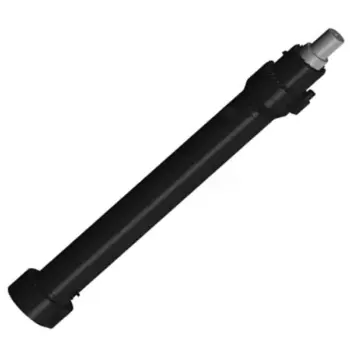Specifications of Heave Compensation Cylinder
| Heave Compensation Cylinder | |
| Application | Compensate the relative displacement of the drag head and the hull when working |
| Bore diameter | up to 400mm |
| Rod diameter | up to 360mm |
| Stroke | up to 4000mm |
| Pressure | up to 32MPa |
| Thrust force | Maximum 1600KN |
A heave compensation cylinder is a hydraulic cylinder designed to offset the relative movement between the drag head and the hull of a trailing suction hopper dredger during operation. This compensation is crucial because the drag head is suspended behind the dredger via a long suction pipe, and wave action can significantly impact the hull’s vertical movement. Without this compensation, the drag head would bounce on the seabed, hindering efficient dredging.
This cylinder is generally connected to both the drag head and the dredger’s hull. It is linked to a hydraulic power unit that provides the necessary pressure for the cylinder’s extension and retraction. A computer system manages the cylinder’s operation, utilizing sensors to detect the movements of both the hull and the drag head.
When the dredger’s hull rises, the heave compensation cylinder extends to maintain the drag head at a consistent depth. Conversely, when the hull descends, the cylinder retracts. This mechanism ensures the drag head remains in contact with the seabed, independent of the hull’s movement.
Heave compensation cylinders are vital for effective dredging operations. They ensure the drag head remains at a steady depth, enhancing the quality of the dredged material and minimizing wear on the dredging equipment.
How does a Heave Compensation Cylinder Work?
- The drag head is submerged, and the heave compensation cylinder extends to maintain a consistent distance between the drag head and the hull.
- As the dredger moves forward, the drag head begins to gather material from the seabed.
- Waves and swells cause the dredger to pitch and roll, but the heave compensation cylinder adjusts its length to keep the drag head at a steady depth and angle relative to the seabed.
- Dredging continues until the hopper is filled with material or the dredging area is exhausted.
- The drag head is lifted out of the water, and the heave compensation cylinder is retracted.
Benefits of Heave Compensation Cylinder on Trailing Suction Dredger
The heave compensation cylinder is a crucial component for any trailing suction hopper dredger. Its use can lead to increased dredging efficiency, reduced costs, and enhanced safety. The advantages of employing a heave compensation cylinder on a trailing suction hopper dredger include:
- Increased dredging efficiency: By maintaining the drag head at a constant depth, the heave compensation cylinder enhances the quality of the dredged material and decreases equipment wear, resulting in notable improvements in dredging efficiency.
- Reduced costs: By lessening equipment wear, the heave compensation cylinder can lower maintenance and repair costs, offering considerable savings for dredger operators over time.
- Improved safety: The cylinder contributes to safer dredging operations by minimizing the risk of the drag head colliding with the seabed or other obstacles, thus helping to prevent accidents and injuries.
Why Choose GBC Dredger Tank Hydraulic Cylinders?
When selecting hydraulic cylinders for dredger tanks, many options exist. However, for a perfect blend of outstanding production capabilities and superior product quality, GBC stands out. We take pride in offering hydraulic cylinders known for their performance and durability.
Our production capabilities are second to none. With cutting-edge manufacturing facilities and a skilled team of engineers and technicians, we guarantee that every hydraulic cylinder we produce meets the highest industry standards. Our dedication to quality is unwavering, and we maintain stringent quality control measures throughout the production process to ensure reliable performance.
Choosing our dredger tank hydraulic cylinders means investing in a quality product that exemplifies excellence. Experience the unmatched durability and performance of our hydraulic cylinders. Make the wise choice today!

